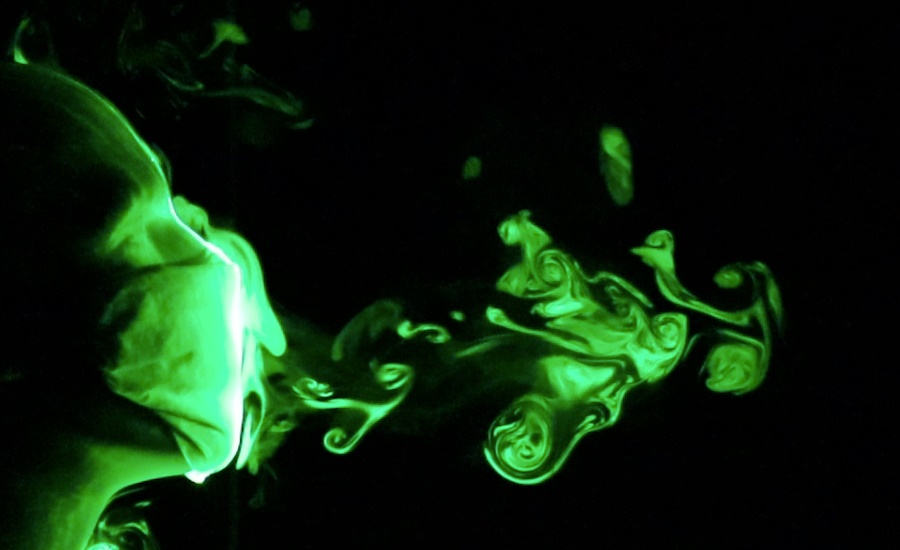When you pass an unmasked person on the street or in the store, it’s become common practice to sigh a little bit and then give them a wide berth. Six feet, if space allows. But a study published just this morning shows that distance might not be enough. Without a mask, researchers say droplets from coughs and sneezes can travel up to 12 feet in less than a minute. And the worst news—those virus-carrying droplets could remain in the air for up to three minutes.
The study was conducted by researchers at Florida Atlantic University’s College of Engineering and Computer Science, and published in the journal Physics of Fluids. The researchers wanted to find out if certain ‘cloth face coverings’ recommended by the CDC were more effective than others. So they put different styles of face masks on a mannequin and took pictures with a laser light sheet.
They found that the worst thing a person can do is to go out in public without a face covering. The best kind of face mask to protect yourself and others while in public: a homemade stitched cotton mask or a cone-style mask bought at a store.
The reasoning behind face masks
If there’s anything we’ve learned from the coronavirus pandemic, it’s that when people cough, talk, or sneeze, tiny droplets go everywhere. This was true before the pandemic, and it’ll still be true after the pandemic. People spread droplets everywhere they go.
We wear masks to protect other people from our potentially-virus-laden droplets. Other people wear masks to protect us from theirs.
That’s because the pathogen responsible for COVID-19 is known to spread through those respiratory droplets we expel when we cough, talk, sneeze, laugh, or breathe. Those droplets can land on healthy people and get them sick (with COVID-19 or with other viruses like the common cold, the flu, tuberculosis, SARS, or MERS). They can also land on surfaces that healthy people touch.
What’s better: Bandanas, stitched masks, or cone masks?
In last place: not wearing a mask. The unmasked mannequin’s cough immediately traveled more than 8 feet. That’s much farther than the CDC’s current recommendation of six feet of social distance. The researchers hope the CDC and other health officials will take note of this finding. It means we should probably revise our social-distancing guidelines to account for how far the virus can travel in the air—especially if people continue to resist wearing masks in public.
This finding could also explain why spikes in cases keep coming out of recently reopened bars and restaurants. Even if tables are spaced six feet apart and restaurant patrons put their masks back on before going to the bathroom or bar, droplets from unmasked people still travel between tables.
Bandanas tested a little bit better. Droplets traveled 3 feet, 7 inches. Folded cotton handkerchiefs kept droplets within 1 foot, 3 inches. Basically: better than nothing. If everyone in public wore a bandana or folded cotton handkerchief and stayed six feet apart, we might be okay.

The best-case scenario: wear a stitched quilted cotton mask or a cone-style mask. Both of those kept droplets within a foot of the mannequin. The cone-style masks you can purchase at most stores these days let droplets travel about 8 inches. But the stitched masks many people have made at home kept droplets within 2.5 inches.

Researchers did notice some leakage through the masks and around the edges, but the stitched and cone-style masks slowed droplets down and kept them close.
Taking action based on the study’s findings
The number one thing to do: wear a mask. Make sure your friends and family understand why wearing masks is so important. The findings from this study show that it’s possible to wear masks effectively without taking resources away from essential workers and first responders who need medical-grade masks and respirators.
If you can sew, make masks for the people you love. Some studies have shown that certain materials are better than others, and if you have an old prom dress around, it might be time to cut it up. There a number of resources for making your own masks.
If you go out in public, wear that mask! And remember that if you see people without masks, their droplets will probably travel farther than 6 feet. Even if they’re asymptomatic or presymptomatic, they can still contaminate their surroundings.
Remember the importance of social-distancing. And stay as far from unmasked folks as you can.
“We found that although the unobstructed turbulent jets were observed to travel up to 12 feet, a large majority of the ejected droplets fell to the ground by this point,” said Manhar Dhanak, Ph.D., one of the study’s authors. “Importantly, both the number and concentration of the droplets will decrease with increasing distance, which is the fundamental rationale behind social-distancing.”
In other words, social-distancing could work to protect ourselves and others from COVID-19, but only if we provide enough distance between ourselves and others. And distancing will be even more effective if people wear properly fitted face coverings.

